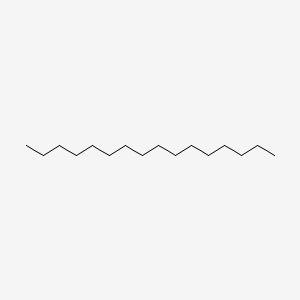| MeSH term | MeSH ID | Detail |
|---|---|---|
| Body Weight | D001835 | 333 associated lipids |
| Coronary Disease | D003327 | 70 associated lipids |
| Encephalomyelitis, Autoimmune, Experimental | D004681 | 26 associated lipids |
| Glomerulonephritis | D005921 | 35 associated lipids |
| Hyperplasia | D006965 | 34 associated lipids |
| Keratosis | D007642 | 9 associated lipids |
| Lupus Erythematosus, Systemic | D008180 | 43 associated lipids |
| Peritonitis | D010538 | 38 associated lipids |
| Serratia Infections | D016868 | 2 associated lipids |
Hexadecane
Hexadecane is a lipid of Fatty Acyls (FA) class. The involved functions are known as Analyte. The related lipids are Fatty Acids and palmitoleic acid.
Cross Reference
Introduction
To understand associated biological information of Hexadecane, we collected biological information of abnormalities, associated pathways, cellular/molecular locations, biological functions, related genes/proteins, lipids and common seen animal/experimental models with organized paragraphs from literatures.
What diseases are associated with Hexadecane?
There are no associated biomedical information in the current reference collection.
Possible diseases from mapped MeSH terms on references
We collected disease MeSH terms mapped to the references associated with Hexadecane
PubChem Associated disorders and diseases
What pathways are associated with Hexadecane
There are no associated biomedical information in the current reference collection.
PubChem Biomolecular Interactions and Pathways
Link to PubChem Biomolecular Interactions and PathwaysWhat cellular locations are associated with Hexadecane?
There are no associated biomedical information in the current reference collection.
What functions are associated with Hexadecane?
Related references are published most in these journals:
| Function | Cross reference | Weighted score | Related literatures |
|---|
What lipids are associated with Hexadecane?
Related references are published most in these journals:
| Lipid concept | Cross reference | Weighted score | Related literatures |
|---|
What genes are associated with Hexadecane?
There are no associated biomedical information in the current reference collection.
What common seen animal models are associated with Hexadecane?
There are no associated biomedical information in the current reference collection.
NCBI Entrez Crosslinks
All references with Hexadecane
Download all related citations| Authors | Title | Published | Journal | PubMed Link |
|---|---|---|---|---|
| Kleinau S et al. | Oil-induced arthritis in DA rats: tissue distribution of arthritogenic 14C-labelled hexadecane. | 1995 | Int. J. Immunopharmacol. | pmid:7591363 |
| Parker ML et al. | Growth of food-borne pathogenic bacteria in oil-in-water emulsions: I--Methods for investigating the form of growth. | 1995 | J. Appl. Bacteriol. | pmid:7615415 |
| Brocklehurst TF et al. | Growth of food-borne pathogenic bacteria in oil-in-water emulsions: II--Effect of emulsion structure on growth parameters and form of growth. | 1995 | J. Appl. Bacteriol. | pmid:7615416 |
| Redpath JL and Patterson LK | Radiosensitization of Serratia marcescens by cetylpyridinium chloride. Evidence for membrane-associated events. | 1976 | Radiology | pmid:766063 |
| Rowland SA et al. | Effectiveness of cleaning surgical implants: quantitative analysis of contaminant removal. | 1995 | J Appl Biomater | pmid:7703533 |
| Cuperus PL et al. | Effects of ciprofloxacin and vancomycin on physicochemical surface properties of Staphylococcus epidermidis, Escherichia coli, Lactobacillus casei and Lactobacillus acidophilus. | 1995 | Microbios | pmid:7791631 |
| Sotsky JB et al. | Frequency of genes in aromatic and aliphatic hydrocarbon biodegradation pathways within bacterial populations from Alaskan sediments. | 1994 | Can. J. Microbiol. | pmid:7804909 |
| Sim SJ et al. | Shikonin production by extractive cultivation in transformed-suspension and hairy root cultures of Lithospermum erythrorhizon. | 1994 | Ann. N. Y. Acad. Sci. | pmid:7832530 |
| Ness-Greenstein RB et al. | DNA from Serratia marcescens confers a hydrophobic character in Escherichia coli. | 1995 | FEMS Microbiol. Lett. | pmid:7867922 |
| Wu Q et al. | Subinhibitory concentrations of antibiotics affect cell surface properties of Streptococcus sobrinus. | 1995 | J. Bacteriol. | pmid:7868618 |
